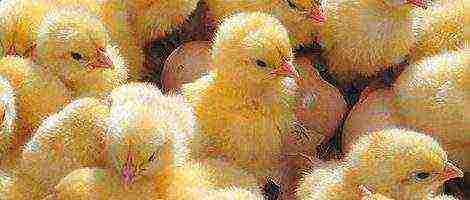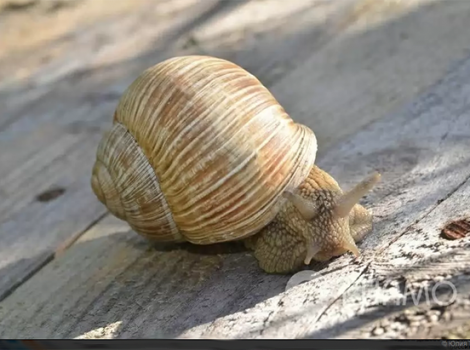Content [show]
Previously, only strawberries were grown in Russia - the berry is fragrant and tasty, but small and not very fruitful, so today this plant is almost never found in garden plots. It was replaced by large-fruited strawberries brought by seafarers to Europe from America. One of its varieties called "Victoria" began to spread with particular speed, and soon all strawberries were called Victoria. To get a rich harvest of tasty and healthy berries, you need to know the rules for planting and growing Victoria in open ground.

Victoria boarding time
The best time to plant strawberries is spring or autumn. In the spring, plants are planted as early as possible - immediately after warm weather sets in and the threat of recurrent frosts disappears. In the fall, Victoria should be planted from the second half of August to September 15, and then next planting season will please the first berry.
Seedlings with a closed root system, purchased in cassettes or containers, can be planted as early as mid-July. The main thing is to choose a cloudy day for planting and moisten the soil well.Seedlings planted in summer will have time to root well before winter and will give a full harvest next spring.
Some gardeners grow planting material with their own hands, although this is a long and laborious process. After all, it will take at least three years to get a full-fledged independent plant. Therefore, experts advise buying seedlings from well-known nurseries, and preferably in cassettes or containers. This is the safest and fastest way to grow crops.

Site selection
The Victoria site should be sunny and level with a slight southwest slope. It is not worth choosing steep slopes for planting this culture, from which the wind blows off the snow in winter, and the spring waters carry away part of the fertile layer. Lowlands and depressions, where melt water lasts for a long time, are unsuitable for cultivating strawberries.
The soil on the site should contain a lot of organic matter. Light loams, black earth, or gray forest soil are best suited for growing this berry outdoors. Groundwater should lie no closer than 1 m to the surface of the earth.
Victoria grows well after herbs, cereals, onions, garlic, petunias, marigolds. You should not plant the berries in the beds where tomatoes, eggplants, cucumbers previously grew. After 3-4 years, the plants are transferred to a new location.
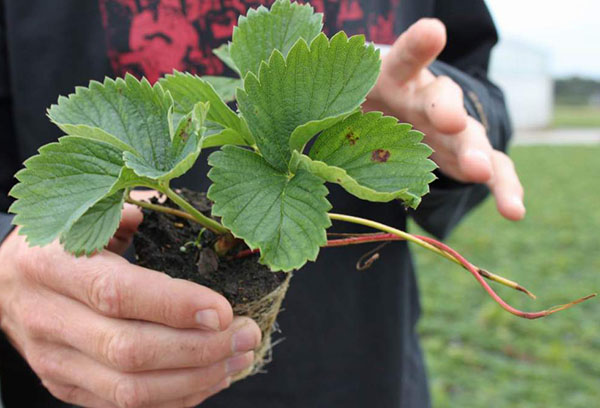
Spring planting
For the spring planting of Victoria, the soil must be prepared in advance, even before the beginning of winter. The site must be carefully dug up, weeds must be removed and the following fertilizers must be applied for each square meter of area:
- humus - 9-10 kg;
- superphosphate - 100 g;
- potassium salt - 50g.
Seedlings for planting in the spring must be selected strong and healthy. Before planting in the ground, it should be hardened for several days by placing it in a cool place.
Between the plants located in the same row, leave 25-30 cm. To ensure ease of maintenance, the beds are separated by aisles of 40-50 cm wide.
Before planting, the roots of the plant are cut to 10 cm and holes are dug to such a depth that the root system fits vertically. When planting a Victoria, special attention should be paid to the location of the neck of the bush.
Important!
The neck of the bush should be flush with the soil surface. With a high planting, the roots can dry out, and with a very strong deepening, the plant can rot.
The planted plant is abundantly watered and covered with a special material to protect it from frost or sunburn.
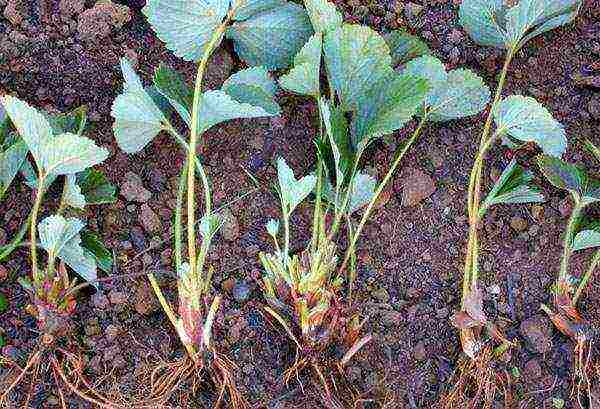
Planting in autumn
Autumn planting of strawberry seedlings is considered optimal, since a full harvest can be harvested from young bushes in the spring of next year. Plants planted in early spring will also start bearing fruit next season, but will have to be cared for all summer.
Before the autumn planting, the site should be processed and prepared in early spring, adding the necessary fertilizers. If every piece of land is valuable in the garden, these beds can be temporarily occupied with onions, garlic or celery, that is, early ripening vegetables.
Before planting seedlings in open ground, the roots should be treated with a fungicide preparation (fungicide) and young plants should be kept in a cool place for several days.
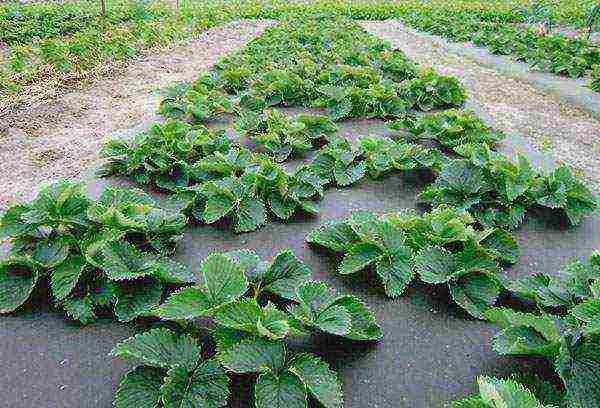
Growing Victoria
In the first year after planting Victoria in the ground, do not strive to get a large harvest. On the contrary, in order for the plant to strengthen and grow the root system, it is necessary to remove the antennae and flowers that appear.
Caring for adult plants involves a number of activities.
- Processing of a plot with strawberries. In early spring, as soon as the growing season begins, it is necessary to collect old mulching material from the beds and between rows, remove dry and damaged leaves, and loosen the soil between the plants.
- Watering. Large juicy fruits cannot be obtained without proper, balanced watering. There should be enough moisture for the normal growth of the plant, and at the same time, strong waterlogging of the soil can provoke rotting of the root system.Victoria is watered once every 10 days at the rate of 10-12 liters per 1 sq. m starting from mid-April. In summer, with the onset of heat, the frequency of watering can be increased up to 4 times a week. In autumn, in August and September, the number of waterings is reduced to 2 times a week. It is better to carry out watering work in the morning, trying not to get water on the leaves and flower stalks. During flowering, drip irrigation is used.
- Loosening. After the next watering, the soil around the plants and between the rows must be carefully loosened, trying not to damage the adventitious roots that lie at the surface of the earth. This is necessary in order to make the soil breathable and facilitate the flow of oxygen into the root system.
- Weeding. Planting maintenance involves regularly removing weeds from the beds and aisles. Weed grass not only depletes the soil, taking away most of the moisture and nutrients, but is also a breeding ground for pathogenic bacteria and a refuge for pests. To stop the appearance of weeds, you can cover the planting area with mulching material: sawdust, wood chips, dry needles - or cover it with agrofibre.
These are the main activities that every gardener who grows Victoria in open areas should regularly carry out.
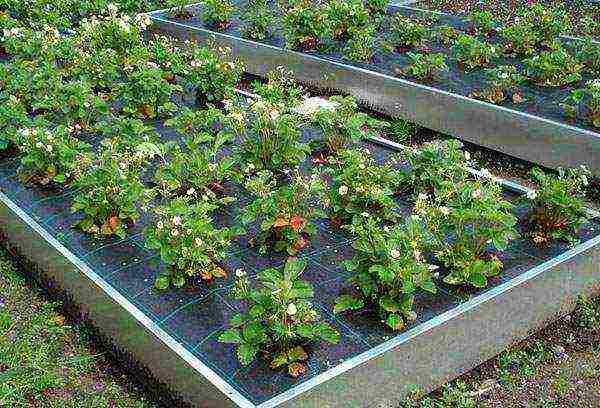
Leaving during flowering
The appearance of the first peduncles falls in mid-May. It is during this period that the future harvest is laid, the quality and quantity of which depends on the correct care. To feed the plant during this period, potash fertilizers, humus and ash are introduced into the soil. You can increase the number of inflorescences using a boric acid solution prepared at the rate of 1 tsp. on a bucket of water, which is sprayed with green bushes.
It is especially important to weed and loosen the area, preventing the appearance and growth of weeds. To get a large berry, you need to use a pruner to remove all excess antennae and leaves that absorb moisture and nutrients from the soil.

Fertilizing Victoria
Caring for Victoria cannot be imagined without feeding this plant. Fertilizers should be applied at least three times per season.
- In early spring, after processing the area allotted for the berry, nitroammofoska is introduced into the soil. Nitrogen, phosphorus and potassium, which are part of this fertilizer, are the most essential substances for plant development.
- During budding, potassium is added to the soil, a large amount of which is contained in ash, chicken manure infusion, and potassium nitrate. After picking the berries, the plants are fed again with nitroammophos, dissolving 2 tbsp. l. in 10 liters of water.
- And the last time Victoria is fed with urea in August. This contributes to the formation of new flower buds and more abundant fruiting in the next year. The solution is prepared at the rate of 30 g of urea per 10 liters of water.
Important!
On sale there is a complex fertilizer developed specifically for strawberries and increasing yields by 30%.
Growing Victoria is an incredibly rewarding and interesting activity, although it requires certain skills and knowledge. After studying the advice of experts and providing proper care for the plants, it will not be difficult to get a decent harvest of this delicious berry.
Victoria is the name of the garden strawberry or strawberry. This variety is considered to be the most widespread and demanded because it is distinguished by its amazing taste and quality. Knowing how to grow a crop, you can get ripe and juicy fruits in large quantities.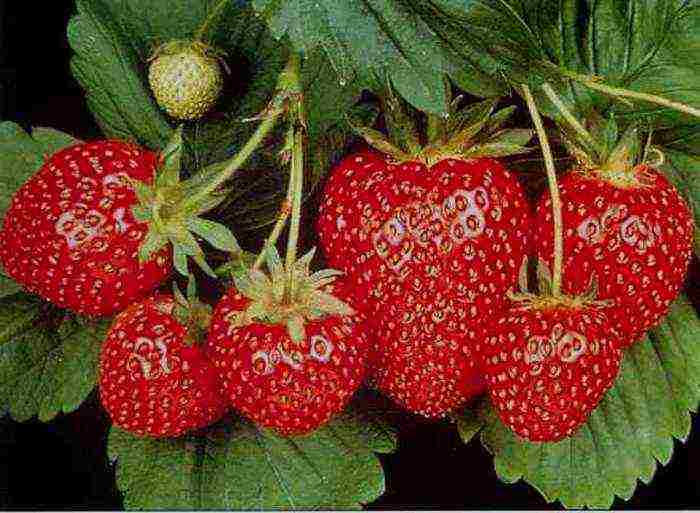
Secrets of growing crops
To grow Victoria, compost, mulch material and heteroauxin should be prepared. It is recommended to choose a place for planting depending on the climatic conditions of the region where it will be grown. In an area with little snowy winters, it is better to plant the plant in spring. This will allow the bushes to grow stronger during the summer season. If you want to get the first fruits in a year, it is better to plant Victoria in late July or early August.Thanks to this solution, the plants will be able to fully develop for another 2 months.
For Victoria, a lighted area with a light, slightly acidic earth is perfect. The best option if potatoes, tomatoes or bell peppers have previously grown in the soil. It is recommended to prepare the soil for planting in 7-14 days. If the culture will be planted in early spring, then the place must be prepared in the fall.
back to content ↑ Video: preparing the garden before planting strawberries
The selected area needs to be dug up, to remove the roots of weeds and various insects from it. If this is not done, then it will not be possible to avoid the attack of pests. After the performed manipulations, it is necessary to improve the structure of the soil. You need to add 2-3 kg of fertilizer to the soil and add the same amount of sand.
Back to content ↑ Planting Victoria in the spring
To get a good harvest of strawberries, it is better to give preference to the remontant variety. This type of culture is characterized by the rapid formation of fruits (2-3 weeks). Victoria is a thermophilic plant, so it must be protected from freezing of aboveground areas, especially in the absence of snow.
Strawberries reproduce through whiskers, which grow abundantly in plants by the second half of summer. 2-3 crops grown next to the mother plant are considered to be of the highest quality for planting. For reproduction of Victoria, it is better to use children from 2-year-old crops.
It is recommended to plant strawberries in even rows, the distance between which should be about 65-75 cm. This will ensure comfort when weeding and watering the plants. There should be a distance of 25-35 cm between the crops. Each bush with a formed root system is placed in a hole 3-7 cm deep. It is imperative to water the culture after planting. This can be done both before falling asleep with earth, and after that.
back to content ↑ Video: how to plant strawberries correctly
Correct plant nutrition
After the end of the growing season, strawberries need additional soil enrichment. But fertilization for Victoria should be done in moderation. With excessive fertilizing, the berries will not be too tasty, gray spots may appear on them.
It is very important for strawberries to find the right nutritional balance. If the amount of dressing is insufficient, the fruits may lose their taste, and the leaves may lose their fresh color. In the first year after planting, Victoria has enough of those fertilizers that were applied at the beginning of growth. From the 2nd year, it is required to add to the soil:
- saltpeter;
- superphosphate;
- potassium.
Each component should be taken at 50 g per 1 m². After receiving the first harvest, it is necessary to repeat the enrichment of the soil in the same proportions. For the feeding process, it is better to choose the time after the rains or water the strawberries abundantly on your own.
Fertilizers are often used to enrich the soil where the plants are located:
- "Fufanon";
- Ordan;
- Abiga Peak.
An effective top dressing is "Gumi-omi".
back to content ↑ Video: secrets of feeding strawberries
Victoria mulching
Mulching strawberries plays an important role in the growing process. Thanks to the mulch, moisture is retained in the soil better. It prevents weeds from climbing to the surface of the soil. The earth is filled with nutrients and becomes very loose. Under the layer of mulch, earthworms are formed, thanks to which the structure of the earth is significantly improved.
The best option for mulch is needles. With the help of such raw materials, various diseases are blocked and the development of pests is stopped. In the absence of coniferous material, dry leaves, straw or grass can be used.
back to content ↑ Video: strawberry mulching
Care secrets
When the Victoria strawberry has faded, it needs to be mulched. Moss or straw is used for this process. The second mulching is recommended in September. For the procedure, waste of grain production or peat is used. The mulch layer is about 6-7 cm.A prerequisite for successful mulching is the preservation of crop leaves from the covering material.
When the crop is harvested, it is required to loosen the soil around the bush. Also, experienced summer residents recommend hilling each plant. To maintain yields, you should systematically weed your beds. For this process, you can use mini hoes and garden rippers.
back to contents ↑ How to water a crop?
Victoria strawberries are considered to be quite demanding for watering. If it is not always possible to irrigate the crop, then work should be carried out to preserve the moisture level in the soil. To do this, you need to loosen the ground, cover the beds with snow, remove weeds in a timely manner and carry out mulching.
Usually strawberries need to be watered 8-10 times a season. Thanks to this, it will be possible to get a good harvest. For irrigation, a garden watering can without a nozzle is used, gently delivering moisture directly to the root of the crop.
back to content ↑ Video: how to water strawberries
Preparing for winter
In the first half of August, it is required to cut off old and dry leaves. This stress will be beneficial for strawberries and contribute to higher yields. A sharp pruner or scissors is recommended for this process. It is required to cut only the leaf plate, leaving small protruding stems. It is imperative to remove all Victoria's mustache. Removing weeds is not recommended by the root, because such raw materials will be a good fertilizer for the next season.
To protect the plants from frost, it is better if they are covered with snow. If in your region there is no such precipitation or there is too little of it, then it is recommended to cover the beds with branches of coniferous trees, tops, straw or dry leaves.
Experienced summer residents advise using spruce branches for such purposes. A good option for shelter is agrotex or spandbond, which is stretched over metal arcs.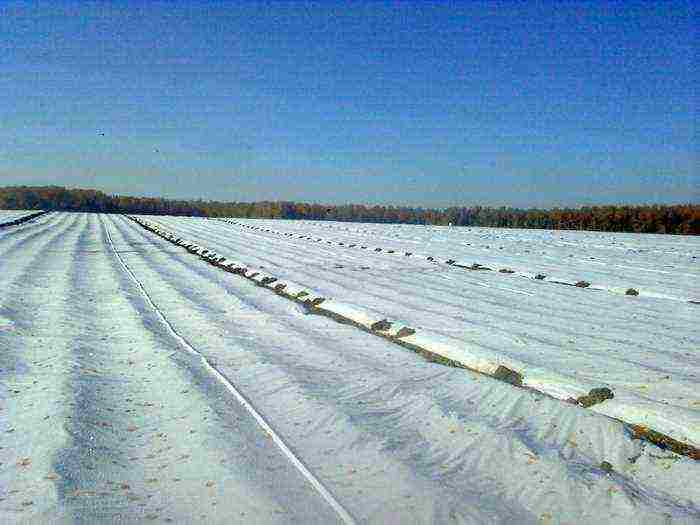
back to contents ↑ How to get large fruits?
How to grow big Victoria fruit? Timely and high-quality fertilization is of great importance for this. For a good harvest, bird droppings are used. 10 liters of the substance is required to pour 30 liters of water. The solution must be infused for 3-5 days. Then the liquid must be diluted with water (1:20) and pour the contents between the rows of Victoria. Before ripening, the grooves can be moistened with boric acid and zinc sulfate fertilizer.
back to content ↑ Video: how to get a large harvest of strawberries
Correct and timely care of Victoria strawberries allows you to get good and high-quality fruits.
Collecting a lot of large berries peeping through the carpet of lush green foliage and exuding a wonderful aroma is the dream of any summer resident. Its execution is within the power of every owner of a personal plot, one has only to take into account the features that Victoria's planting has, and competently care for the plants. They will certainly thank the caring owner with a generous harvest. The proud name "Victoria" hides the strawberries familiar to everyone. Initially, only one of its varieties was called that - the one that the navigators brought to Russia from America. Over time, there were more varieties of strawberries, among them remontant ones appeared, capable of bearing fruit from 3 to 5 months a year. But in some areas, the name stuck so well that it became a household name.
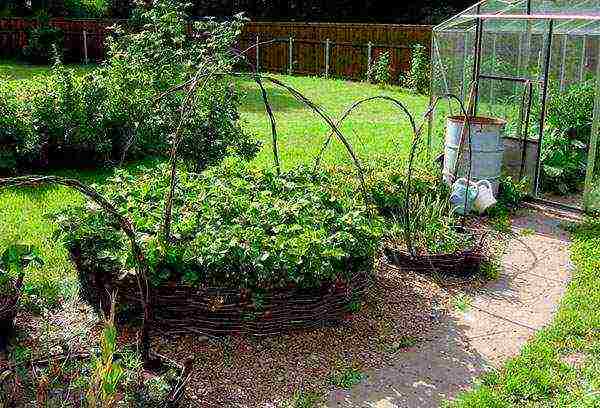
Requirements for the site and soil quality
For growing Victoria in the garden, you should choose an open place that receives the most sunlight. Strawberries thrive on flat or sloping areas to the west. A prerequisite for plant health is reliable protection of plantings from the wind. In spring and summer, it is not terrible for Victoria, but in winter it can blow off the snow that protects it from freezing from strawberries.
You can count on a rich harvest if the crop is grown on light soft porous soils with a significant admixture of sand.Victoria is hygrophilous, but she reacts poorly to stagnant water, so she needs a well-drained soil. For cultivation of strawberries, damp swampy lowlands are categorically not suitable. It is not recommended to plant it in areas prone to flooding and in places where water from melted snow stands for a long time in spring.
Repaired Victoria is demanding on the fertility of the soil, it should contain a lot of humus. The ideal option for her is black soil or dark gray forest soil. But in other conditions, strawberries can develop successfully if you properly care for their bushes. Heavy clay soil holding moisture will need to be diluted with manure or humus and sand. The procedure is carried out in the fall. Soil with an acidic reaction is necessarily lime.
You should not plant Victoria in areas where any plants from the Compositae family were placed last season (sunflower, earthen pear, lettuce, asters, chrysanthemums). It is undesirable, but it is possible to breed it after all nightshades (tomatoes, potatoes, peppers, eggplants), as well as cucumbers. But the areas vacated after harvesting cereals, legumes (beans, peas), cabbage crops (radishes, radishes, mustard), garlic and parsley are very good for Victoria. Before planting, they must be dug up, enriching the soil with fertilizers. For 1 m² of surface, it will be correct to apply:
- 2 buckets of humus;
- 2 liters of wood ash.
The necessary organic and mineral substances will provide strawberry seedlings and a nutritional composition of the following components:
- ammonium nitrate (20 g);
- superphosphate (25 g);
- potassium salt (20 g);
- humus (6 kg).
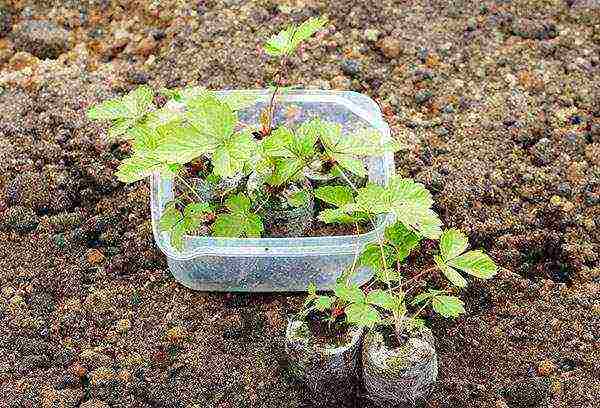
Preparing to disembark
In terms of planting dates, Victoria provides summer residents with ample opportunities. It is propagated from spring to autumn. Professionals advise planting strawberries in late April or May, when the weather is already warm. If you provide the young bushes with proper care, in the spring they will quickly take root in a new place, they will hurt less and will bring the first berries in June.
Advice
For planting, the strongest rosettes with a powerful root system are selected.
It will be easier to take care of Victoria if you prepare a plot for her in advance. In the fall, they dig it up, picking weeds, and apply fertilizers. Remnant strawberries can delight with berries from May to October, but they need a lot of nutrients for stable fruiting. Therefore, in the spring, the soil is re-enriched with rotted manure (10 liters of substance per 1 m²). This is done 17–20 days before planting.
It is correct to carry out the autumn breeding of Victoria from the second half of August to the first decade of September, when the probability of frost is minimal. While it is warm, the plants will have time to take root and withstand the cold. Caring for strawberries at this time will not be burdensome, you just need to plant the sockets in the soil prepared in advance - from June -. If a remontant variety of culture is chosen for breeding, its features must be taken into account. Constant fruiting greatly weakens the plants, therefore young bushes of such a Victoria often die in the first year of life. You will have to take care of them more carefully.

Landing rules
Most often, strawberries are bred with a mustache, which its bushes release by mid-summer. Young shoots of Victoria emerge from the nodes located on them. Experienced summer residents advise planting sockets that are closer to the mother bush - the first 2-3. The shoots obtained from 2-year-old plants have the highest survival rate.
When 4-6 leaves appear on the rosettes, they are separated from the mustache, carefully removing the roots along with an earthen lump, and placed in a hole previously spilled with water. The depth of the hole is usually 10-15 cm. It can vary depending on the degree of development of the underground part of the plant. For mature bushes with strong and long roots, it is better to make deeper holes.To make the remontant strawberry easier to take root in a new place, before placing it on the garden bed, its roots must be dipped in a clay chatterbox. It is prepared by mixing two components with water until a creamy state:
- 1 bucket of clay;
- ½ bucket of mullein.
It will be easier to care for the plantings if you place the strawberry bushes in rows. Many summer residents prefer to fill them with peculiar ridges up to 10 cm in height. The distance between neighboring plants should be 30-40 cm, and the interval between the rows is made equal to 60-70 cm. The soil is poured into the hole with a slide, the victoria bush is lowered onto it and its roots are gently spread in different directions. Then the hole is filled with soil. It is correct for the root collar of the bush to rise slightly above the ground or be flush with it. The soil is slightly compacted and the hole is watered abundantly.
Advice
When planting, you can add special preparations to the fossa to promote rapid rooting.
Gardening strawberries respond well to soil mulching. A layer of dry grass, foliage, algae, hay, small straw, needles will help maintain the soil moisture level necessary for the crop. After planting, they are recommended to cover the space under the plants and between the rows. The care carried out in the spring in the form of mulching will have a positive effect on the yield of Victoria: strawberries will bring more berries, and they will ripen faster.
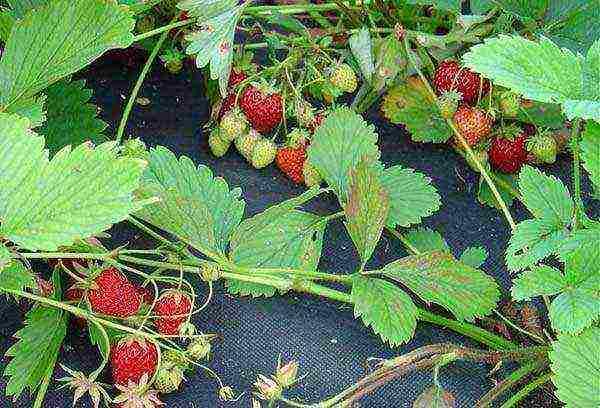
Features of agricultural technology
Growing Victoria does not require special skills, but you will have to pay attention to plantings. Caring for them includes standard procedures:
- watering;
- weeding;
- mulching;
- top dressing;
- loosening.
Both remontant and ordinary strawberries are sensitive to drying out of the soil, reacting to it with a decrease in yield, therefore they often moisturize it. You can significantly increase the time interval between waterings if you regularly loosen the soil, mulch the beds, and take snow retention measures in early spring. Victoria moisturizing treatment is required from 4 to 10 times per season, depending on weather conditions. The end of summer and the beginning of autumn is an important period in the life of plants: flower buds are laid in them. If you do not water the plantings at this time, it is better not to pin hopes for a good harvest next year.
During the Victoria season, at least three additional fertilizing with complex mineral fertilizer is required. Organic compounds are also suitable for her. Experienced gardeners recommend using a mullein diluted in a ratio of 1:10 for her. It is better to pour it on moist soil. Two dressings are carried out in the spring: after harvesting dead leaves and when the first flower stalks appear. At this time, the plantings require intensive care, the correctness of which depends on the quality and quantity of the crop. To enhance flowering and increase the number of ovaries, strawberries are sprayed with an aqueous solution of boric acid. They do this while there are no buds on the bushes yet. When the peduncles come out and the berries begin to tie, they are treated with zinc sulfate.
Advice
To get larger berries, Victoria's mustache is cut off during the ripening period.
After the plantings have faded, they do not stop caring for them. The distance between the plants and under them is mulched with straw, sawdust or dry moss. This measure will prevent gray mold from damaging the crop. Having collected the last berries from the bushes, they proceed to the third feeding. After it, the soil is loosened well. If the roots of the plants are peeking out of the soil, it is necessary to spud the plantings. On the eve of autumn frosts, one more mulching is carried out using peat, humus or grain waste. They are laid in a thick layer, not less than 5-8 cm. To protect the strawberries from freezing, dry foliage, straw are thrown onto the beds or covered with spruce branches.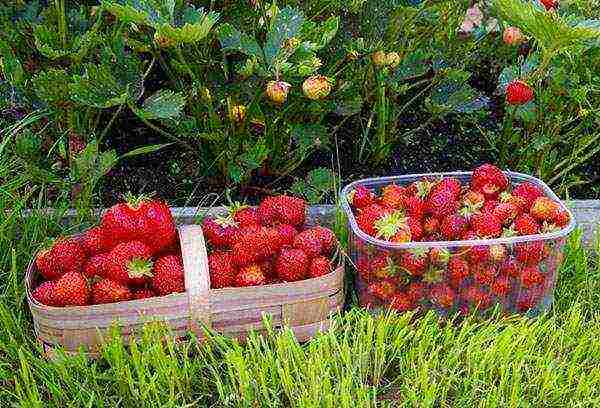
It is impossible to resist the tasty and healthy Victoria berries, which is why its cultivation has become a tradition for most summer residents. They are good not only fresh, there are a lot of recipes for winter preparations from garden strawberries.There are compotes, and jams, and jam, and preserves, and jelly, and marmalade. Victoria fruits can be dried, frozen, covered in their own juice, made into syrups, liqueurs, wine. They are combined with other fruits and berries - red currants, gooseberries, apricots, peaches, raspberries.
Strawberries cannot be called a capricious culture, although you will have to spend time and effort caring for them. But they will definitely pay off. Subject to simple recommendations, it will be possible to harvest from the bushes already in the first or second year of their life - depending on the selected variety.
 Orchard strawberries, often called victoria, have gained wide popularity and distribution in the gardens of various regions of the country. This is due to the simplicity of its reproduction, the early maturity of the culture, the convenience of protection from the harsh weather conditions of winter, and the high dietary and taste qualities of berries. Many gardeners get high yields of Victoria every year, having mastered her agricultural techniques well.
Orchard strawberries, often called victoria, have gained wide popularity and distribution in the gardens of various regions of the country. This is due to the simplicity of its reproduction, the early maturity of the culture, the convenience of protection from the harsh weather conditions of winter, and the high dietary and taste qualities of berries. Many gardeners get high yields of Victoria every year, having mastered her agricultural techniques well.
Soil and planting site for Victoria
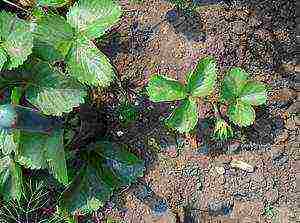 It is necessary to plant the plant on a plot of land with a slight slope to the west. The place should be protected from the winds... After all, in winter, Victoria is protected from frost by snow, which means that in no case should it be blown away by the wind. The exposed berry can freeze and die. It is desirable to choose sandy loam soil rich in humus.
It is necessary to plant the plant on a plot of land with a slight slope to the west. The place should be protected from the winds... After all, in winter, Victoria is protected from frost by snow, which means that in no case should it be blown away by the wind. The exposed berry can freeze and die. It is desirable to choose sandy loam soil rich in humus.
Others are added to it. fertilizers... It is better to apply fertilizers in the fall, spreading them evenly and digging them with a shovel. In spring, shallow loosening is necessary in order to level the surfaces and close the moisture. For one square meter of soil where strawberries will be planted, you will need:
- twenty grams of potassium chloride;
- twenty grams of ammonium nitrate;
- twenty-five grams of superphosphate;
- six kilograms of humus.
It is best to alternate Victoria's landing with vegetable crops... The best predecessors for this berry are: green spaces (dill, parsley, lettuce), legumes, garlic, onions, root vegetables. And it is not advisable to plant it after potatoes, as the plant can get sick with a nematode.
Reproduction and planting
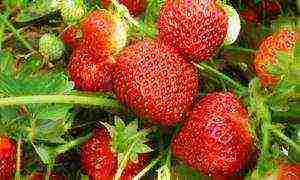 By the middle of summer, adult Victoria plants grow antennae, on which nodules are located, giving in the future roots and leaves. With the help of such antennae, Victoria reproduces. The three sockets on the mother plant are considered to be of better quality. When four to six leaves appear on such a rosette, it should be separated from the mother plant for planting in a permanent prepared place. In order for the plant to take root quickly and well, it is necessary to dig out sockets with a clod of earth.
By the middle of summer, adult Victoria plants grow antennae, on which nodules are located, giving in the future roots and leaves. With the help of such antennae, Victoria reproduces. The three sockets on the mother plant are considered to be of better quality. When four to six leaves appear on such a rosette, it should be separated from the mother plant for planting in a permanent prepared place. In order for the plant to take root quickly and well, it is necessary to dig out sockets with a clod of earth.
Many gardeners plant strawberries in beds ranging from eighty to one hundred centimeters wide and up to fifteen centimeters high. The edges of such beds can be edged with boards, and the aisles can be covered with sawdust.
Victoria is planted throughout the growing season from early spring to the middle of the last month of summer. Planting dates are determined by the availability of the outlets.
For the spring period, the rosettes are grown in seedling beds or dripped near the mother bush. In this case, Victoria will bear fruit already this year, albeit slightly.
Very common tape two-row planting scheme... In this case, between the rows in the tape, the distance is made about forty centimeters, between the tapes themselves up to eighty centimeters, and between the plants from twenty to thirty centimeters. In this case, up to ten plants are placed on one square meter.
The planting density depends on the Victoria variety and growing conditions.
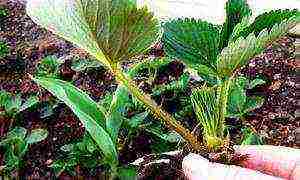 Before planting seedlings, you should dig grooves or holes up to ten centimeters deep and water them well. Then plant seedlings in them and water it again well.
Before planting seedlings, you should dig grooves or holes up to ten centimeters deep and water them well. Then plant seedlings in them and water it again well.
It is best to land in cloudy weather or in the evening. This improves the survival rate.
In order to properly care for young Victoria seedlings, you should not forget her in time to water... Watering should be especially regular during the first two weeks. If the weather is dry, then watering should be daily, and only then once every two or three days.
How to care for mature Victoria bushes
Spring chores
-
 After the snow melts and the top layers of the soil of the beds with Victoria dry, all debris and dried leaves should be removed from them. Old whiskers and leaf stalks are best trimmed with pruning shears. Victoria bushes that have not survived the winter frosts should be removed along with the roots. Weeds that have grown in late autumn are also removed. All of these plant residues are composted with manure or incinerated off-site.
After the snow melts and the top layers of the soil of the beds with Victoria dry, all debris and dried leaves should be removed from them. Old whiskers and leaf stalks are best trimmed with pruning shears. Victoria bushes that have not survived the winter frosts should be removed along with the roots. Weeds that have grown in late autumn are also removed. All of these plant residues are composted with manure or incinerated off-site. - After the soil on the beds and row spacing has dried, it is loosened to a depth of about four centimeters, then the surface is leveled, crushing lumps and dusting with ash.
- Fertilizer can now be applied. First of all, when caring for Victoria in the spring, organic fertilizers are applied, for example, sawdust or straw. To do this, they are first crushed and sprinkled a little around the bushes. You can also add peat chips or humus.
- It is desirable in mid-April, and if it does not work out, then in May, treat Victoria from pests. It will be enough to water the plants with a weak solution. copper sulfate... After such watering, the first buds will begin to bloom on the plant.
- Although Victoria is a moisture-loving plant, excessive moisture has a negative effect on her. When caring for a plant, it is advisable to combine its watering with protection from pests and fertilizers. Some gardeners do the first spring watering hot water.
- After harvesting, watering and sprinkling with organic fertilizers, victorias are required nitrogen fertilizers... They are introduced only after the first leaves appear on the plant. To do this, combine the cowshed and ammonium sulfate, dilute with water and water the Victoria.
- In the morning, plants should be watered once a week in spring. warm water... Before flowering, watering can be done by sprinkling. During the flowering of Victoria and when there are already berries on it, watering is done carefully so that no water gets on them.
- Already in the spring we will have to fight weeds. If the aisles are mulched with sawdust, then there will be no weeds, and water with fertilizers will flow directly to the tubers.
How to care for Victoria in the summer
- Weekly watering of plants.
- Weeding Victorian weed beds.
- Mandatory inspection of plants for diseases and pests.
- When the first berries begin to tie, be sure to add straw or sawdust. Then the fruits will not get dirty and rot.
- Mandatory removal of damage to parts of Victoria or the damaged bush itself, so that other plants do not get infected from it.
- Before flowering, fertilizing with a solution of nitrophoska or potassium sulfate.
- The berries must be picked regularly, along with the stalk.
- After harvesting Victoria, until the tenth of August, the bushes should be fed with wood ash and nitrophos.
- Cover the beds with foil during heavy rains so that diseases do not develop and the berries do not become watery.
- In a timely manner, the antennae should be removed from the fruiting Victoria in order to prevent rooting of the rosettes. The antennae are left only if seedlings are needed to resume planting. Leave them near the uterine rosettes.
- After harvesting, the soil is loosened, and if the roots are bare, then the bush is spud.
Autumn work or Victoria's preparation for winter
-
 The soil must be followed after flowering grind... This is done with wood chips, straw or dry moss. It helps to protect the berries from gray rot. The same procedure is repeated again by mid-autumn, but using peat or grain production waste. The layer thickness should be between five and eight centimeters.Leaves should not be covered.
The soil must be followed after flowering grind... This is done with wood chips, straw or dry moss. It helps to protect the berries from gray rot. The same procedure is repeated again by mid-autumn, but using peat or grain production waste. The layer thickness should be between five and eight centimeters.Leaves should not be covered. - To prepare Victoria for winter, not only mustaches are cut from the bushes, but also leaves at a distance of ten centimeters from the ground. This should not be scary, since new leaves will still appear before winter, and the plant will get stronger.
- Cut bushes should be sprayed against diseases and pests.
- Feed the plants with mineral fertilizers. This is necessary in order for Victoria to accumulate them for the formation of new leaves and berry buds.
- In areas where winter is not very snowy, Victoria takes refuge. You can use ordinary straw, tree branches, fallen leaves. Often some special covering material is used for this purpose. You can also cover it with a film, but be sure not to forget to remove it in the spring no later than the beginning of May.
Protection from pests and diseases
An important role in the care of Victoria is its protection from diseases and pests. The most common pests of Victoria are strawberry mites and nematodes. And from diseases: gray rot of berries, powdery mildew and white spot of berries. But how to take care of Victoria to prevent this from happening? To prevent such diseases and pests, you should:
-
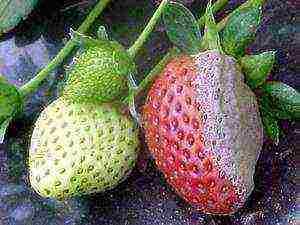 plant seedlings only healthy;
plant seedlings only healthy; - use varieties that are resistant to diseases and pests;
- avoid thickening of the bushes;
- during the ripening of berries, limit watering;
- remove berries and leaves that are damaged;
- keep seedlings from healthy mother plants for fifteen minutes in hot (forty-six degrees) water to destroy the nematode and strawberry mite;
- it is recommended to plant calendula, onions, marigolds, garlic, immortelle in the aisles of Victoria bushes to combat the nematode.
Following all the recommendations for caring for Victoria in the garden, the plant will thank you with a rich and tasty harvest.
 Any gardener will sooner or later want to plant strawberries on his plot. But how to care for Victoria in order to get a good harvest?
Any gardener will sooner or later want to plant strawberries on his plot. But how to care for Victoria in order to get a good harvest?
This question worries many gardeners who first planted this berry crop on their site. Is it difficult to care for this plant? At first glance, it may seem that yes. However, if you consider some basic recommendations for caring for Victoria, it turns out that this activity is not so difficult. Of course, it can be difficult at first, but with a little practice and you will become a guru in growing strawberries. And in this article you will receive comprehensive answers to important questions about the agricultural technology of this berry crop.
How to plant Victoria
So, let's consider the first question - how to plant Victoria? The answer to it is important, since it is the planting of strawberries that affects the quality of the future harvest.
To understand how to plant strawberries, you must first briefly consider the structure of its bushes. Take a look at the photo attached below. As you can see, there is a main, uterine bush. It is thanks to him that the multiplication of berry culture is possible. A mustache extends from the main strawberry bush. Rosettes appear on these processes - future fruiting bushes. Over time, this rosette will also develop into a mother bush.

Important! For reproduction, choose those shoots on which no more than three outlets are located. This will ensure the stable growth of each bush, which will affect the quality of the fruit.
As soon as the rosette begins to form, immediately stick its roots gently into the soil. This will provide the plant with constant nutrition with important vital elements. After a while, when the bushes are formed, they can be planted. It is worth noting that each mother bush can produce up to 15 good rosettes. This means that you do not have to constantly buy seedlings, and you will always have your own.
Memo. You need to plant Victoria in the middle of summer (in July). Many gardeners are advised to choose the evening time of the day for this: in this case, the plant will undergo night acclimatization.
What bushes can be planted in the ground? Will all sockets fit? No, you need to plant only those seedlings that have a root system, there are several leaves and a heart is developed. Therefore, if you buy outlets, then pay attention to all these factors, so that later you do not get upset because your plant did not take over. In the same case, when you have your own uterine bush, then, before carefully tearing off the outlet from the mustache, make sure that it matches this description. Before planting the plant, gently straighten its roots.
Of no small importance is the place chosen for Victoria's landing. Berry culture develops well on sandy loam, slightly acidic and loamy soil. Don't forget to saturate the soil with humus and important nutrients. You cannot plant the plant in clay soil (it will die) and sandy soil is not recommended (the harvest will be small).
Memo! Avoid planting strawberries in garden beds next to peppers, tomatoes, and potatoes. Also, do not plant seedlings near trees: their root system will interfere with the development of Victoria. But the neighborhood with corn and sunflower will be very useful - they will protect the berry crop from the winds.
The plant does not like high humidity, low temperatures and cold winds. Such weather conditions adversely affect the productivity of the variety: the harvest will be small, and the fruits themselves become small and sick. But warm and sunny places will contribute to the fact that Victoria will bear fruit abundantly with large and beautiful berries.
How to water Victoria
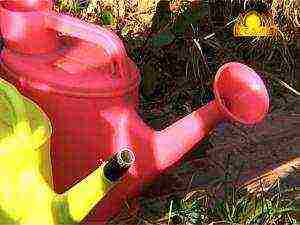 Strawberries are considered a moisture-loving plant. So is there any specific advice on how to water the Victoria? It turned out that yes.
Strawberries are considered a moisture-loving plant. So is there any specific advice on how to water the Victoria? It turned out that yes.
In the first month after planting, the plant must be watered in the holes. After 30 days, the bushes are irrigated by filling the beds with water. It turns out that it is from this period that Victoria begins to receive abundant moisture. In this case, many gardeners do not reinvent the wheel, but simply bring the end of the hose to the garden bed and fill it to the top. Yes, you shouldn't be greedy for water. For such generosity, Victoria will present you with her large, tasty fruits. You can find out what to do with this bountiful harvest here.
How often to water Victoria
It is clear that strawberries need abundant watering. But still, how often to water the Victoria so as not to harm the plant?
In spring, strawberries begin to grow rapidly. If she is not given the necessary moisture during this period, then you should not be surprised that the berries ripened small and dry. Watering continues almost until mid-autumn. In the spring and fall seasons, strawberry bushes need to be watered once a week. This should be done in the morning and preferably with warm water. In the summer season, it is necessary to water Victoria at least twice a week, and if the days are hot, then you can do it every other day. In this case, one must not forget to fertilize the plants with liquid subcrustations.
How to care for Victoria in spring
The spring season is the most laborious. It is at this time that strawberries need special care. Therefore, how to care for Victoria in the spring?
You have just finished eating frozen strawberries, when spring comes to the yard, and with it it is time for you to go out to your site. Where to begin? First, take a close look at your beds. Remove all frozen plants without regret: they have nothing to occupy space in the beds. Dead leaves must be removed from living bushes.
After carefully examining the bushes and removing the dead, move on to the next step: remove the top layer of earth with which you mulched Victoria last fall. Why is this done? Firstly, various pests live in this layer, which have taken refuge here from the cold weather, and secondly, the root system will begin to receive additional heat from the rays of the sun.
When you have finished all these procedures, it is advisable to feed the strawberries with nitrogen fertilizer.As soon as your bushes are pleased with new leaves, then immediately "feed" your plants with a mullein solution with the addition of ammonium sulfate. And when May comes, Victoria should receive a portion of the complex mineral fertilizer.
How to grow a big Victoria
 So, all the main work has been done. The gardener is waiting for its fruits. But how to grow a large Victoria, because every gardener wants to get a special trophy?
So, all the main work has been done. The gardener is waiting for its fruits. But how to grow a large Victoria, because every gardener wants to get a special trophy?
In fact, a lot depends on the gardener himself, or rather on whether he will help Victoria in her fruiting. What is it about? Again, about fertilization. And it doesn't matter what you are doing - trying to grow cherries from a stone or want to get a large Victoria fruit - correct and timely fertilization in these matters will play a key role.
Make it a rule to fertilize plants not only in spring (as mentioned above), but also before flowering and ripening. In the first case, it is advisable to feed the strawberries with bird droppings. The solution is prepared as follows: one bucket of manure is filled with three buckets of water. The liquid should stand for three to five days. The resulting solution is diluted 1 in 20 and the grooves between the beds are watered with it. And before ripening, Victoria should be fertilized twice: with boric acid and zinc sulfate. Thanks to all these actions, you can expect a bountiful and large-fruited harvest.
In addition to the information in the article, you can listen to tips from one of the gardeners on how best to care for strawberries:
We also recommend that you familiarize yourself with the materials:
IMPORTANT! To bookmark the article, click: CTRL + D
How to properly grow Victoria in the garden
How to Grow Victoria in the Garden | How to plant Victoria in the spring
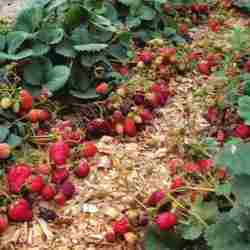 Garden strawberry is a plant that is called strawberry, and sometimes victoria, because this variety is the most revered among the rest due to its excellent taste and quality.
Garden strawberry is a plant that is called strawberry, and sometimes victoria, because this variety is the most revered among the rest due to its excellent taste and quality.
If you don't know how to grow Victoria, choose a strawberry variety based on your local climate. Victoria propagates by rooted bushes that form on the stems of the shoots.
In this article, you will learn how to grow Victoria in the garden and how to plant Victoria in the spring.
How to grow Victoria in the garden?
In order to grow Victoria you will need:
The time to grow Victoria must be chosen taking into account the climate of the area where you will plant it. If your region has a frosty winter with little snow, then it is better to plant Victoria in the spring. Then over the summer, the plants will be able to get stronger. If your area has a milder climate, then you can postpone planting Victoria until autumn. If you want to get a harvest in the first year, then you can plant young plants in the ground in July or August.
How to plant victoria correctly?
In order for the plant to develop quickly and give a high-quality good harvest, you need to grow Victoria in a well-sanctified area in a place where the soil is light and not swamped. On this soil, potatoes, peppers or tomatoes should grow for several years before. If you want to plant Victoria in the spring, then the soil must be prepared in the fall. And for summer or autumn planting of strawberries, it is enough to prepare the soil one to two weeks before planting.
You need to dig up a piece of land by removing the roots of perennial weeds, grubs and wireworms. Otherwise, they will damage the roots of garden strawberries and it is better to get rid of this problem in advance. Next, you need to improve the structure of the soil, add several kilograms of fertilizer and add sand to the soil.
You need to plant Victoria in the spring in wet, cloudy weather. The prepared bed should be watered quite abundantly a couple of days before planting.
How to grow Victoria in the garden?
When planting Victoria in the spring, you must separate the rooted rosettes from the shoots. In this case, it is important to dip the open roots of the rosettes in a mixture of heteroauxin, water and clay.You need to plant strawberries in rows, at a distance of about 60 cm from each other. You also need to leave a gap of up to 30 cm between the bushes. Before planting Victoria, you need to spread the roots of the plant and sprinkle them with earth so that the growing point does not fall below the soil level.
After these steps, be sure to water the garden bed and sprinkle the soil with a layer of sawdust. If you have a mulching nonwoven, you can flatten it in the garden before planting, and then secure the edges. Where the victoria is located under the mulching material, holes need to be cut.
How to plant Victoria in the spring?
If you want to get a rich harvest of garden strawberries or Victoria several times per season, then you need to grow a remontant Victorian variety. In this species, the fruits are formed in just two to three weeks. At the same time, the first harvest can be obtained already on last year's inflorescences, and the second, the most abundant, in August-September.
Victoria belongs to a fairly thermophilic plant. A sharp drop in temperature in autumn can cause freezing of the entire aboveground part of the plant, especially in the absence of snow cover. And strong freezing of the soil can even cause the death of the roots.
Soil for Victoria
There is nothing difficult in how to plant Victoria correctly. To grow Victoria, you can choose almost any soil in your garden. However, there is of course a link between yield and soil type.
The best results can be achieved if Victoria is grown on podzolized chernozem soils or on dark gray soils of medium to light composition.
On peaty, light gray and soddy-podzolic soils, the harvest will be much less rich.
Groundwater should lie at a depth of at least 60-70 cm.
For planting Victoria, the slopes of the southwest direction are best suited, since the growing season begins earlier on them, and the berry harvest ripens faster.
It is highly discouraged to use closed and low-lying areas for planting strawberries.
The acidity of the soil should be practically neutral.
The eternal enemy of not only potatoes, but also Victoria is the Colorado potato beetle. Therefore, before planting Victoria in the ground, it should be checked for the presence of wireworms and May beetle larvae.
How to plant victoria correctly?
Planting Victoria Seedlings
Before planting, seedlings must be kept in a cool place for five days.
The best soil for growing Victoria is moist, but not wet soil.
During planting, it is important to ensure that the seedling box is in the shade at all times.
If you did everything correctly, then the root system will be located vertically, and the root collar will be at ground level.
Overly long roots should be shortened to 10 cm and then watered.
To prevent crust formation on the upper soil layer, it should be mulched with dry earth or humus.
It is important to ensure that the aisles are not overgrown with weeds, therefore, the site for Victoria must be cleared of pathogenic bacteria and pests. At this time, the most popular is plant protection in the form of entomophagous insects.
Victoria care
Caring for Victoria in the garden involves loosening the beds and weeding. This should be done in dry weather. And after harvesting, the leaves must be removed, the Victoria must be cut off. The process of pruning on fruitful bushes, which takes place for several years without removing strong shoots with young rosettes. These sockets can be used to renew Victoria next year.
Weeding Victoria is an important stage in its cultivation and care, as this is what guarantees the appearance of high-quality berries of good taste and large size. If your strawberry rows are overgrown with weeds and the soil is firm, your strawberries may degenerate and stop bearing fruit.So, be sure to take care of Victoria - water, weed rows and destroy weeds, monitor the state of the garden to avoid the appearance of larvae.
How to grow Victoria
Victoria - a delicious victory with little secrets
Greetings, dear readers!
p> One of the first varieties of the well-known garden strawberry is the Victoria berry. Victoria fruits have an extraordinary aroma; they look beautiful and appetizing on a platter. Victoria is a berry that has many valuable properties and contains nutrients. It contains vitamin C. The name Victoria is very suitable for this berry. To feel Victoria - victory - you need to see a well-groomed garden of beautiful berries. And for this you need to properly care for the plant.
Let's talk about how to grow victoria in the garden area.
p> Victoria breeds with a mustache. They usually appear by mid-summer. For further cultivation of the plant, use the rosettes located next to the mother bush. Mustache from biennial plants works best. You need to plant a rosette with four leaves on the ridge, separating it from the common plant.
Victoria bushes are planted in spring or autumn. But at the same time, the site for planting is prepared in advance. For spring planting, the beds are prepared in the fall, and for the fall - in June, not forgetting to fertilize the soil. It is advisable to plant Victoria on level ground with a slope towards the west. In winter, snow should accumulate on the site, so that the Victoria bushes do not die. In this regard, the garden bed must be positioned so that it is not strongly blown by the wind.
In order to plant the bushes, it is necessary to make holes in the prepared bed in which the mustache dug out together with the lump of soil are placed. This should be done immediately, without leaving the outlet for the next days.
Berry - Victoria is susceptible to gray mold infection. to prevent this disease, the soil on the ridge is mulched with wood shavings or straws, 10 cm thick. At the same time, the leaves of the plant are not covered. When the crop is harvested, the ground around the berry bushes must be loosened. When the roots are exposed, the berry is huddled, regular weeding of Victoria is the key to getting a good harvest.
Before flowering, in order to prevent gray rot disease, it is necessary to spray with an iodine solution.
Special requirements apply to the watering of the bushes. Moderate watering of the plant will allow you to save a large amount of vitamin products. Without additional moisture, Victoria will grow if you cover it with snow in winter, carry out high-quality weeding, and do timely and regular loosening of the soil.
For today it's all about how to grow victoria Location on.
Don't miss out on the chance to eat some victoria berries. Its taste is canceled, and the benefits are immeasurable. When consumed, you must carefully rinse the fruit under running water. You can use garden strawberries for fasting days due to their low calorie content. Drinking a decoction of berries and leaves will help you lose those extra pounds.
See you, dear friends!
You can read more:
- How to grow raspberries correctly HOW IT IS CORRECT TO GROW Raspberries IN A GARDEN PLOT Hello, dear friends! What I'll cover in this article: A quick overview of the useful ones.
- How to grow honeysuckle Hello dear friends! One of the earliest berries is honeysuckle, which ripens even before strawberries. In garden plots with everyone.
- Why do tomatoes crack Hello, dear friends! In today's article, I will answer the question of why tomatoes crack in greenhouses and in the open field. Cracking.
- How to grow cucumbers in a greenhouse How to grow cucumbers in a greenhouse What does our cucumber like? So, the ancestors of cucumbers lived in the tropical jungle. It's very hot in the jungle.
- How to grow pepino How to grow pepino Hello dear friends! Today I want to introduce you to an exotic culture.This is PEPINO or melon pear -.
- How to grow rhubarb Hello dear friends! Rhubarb contains citric and malic acid, pectin substances, sugars, mineral salts, vitamin C. Usually used in food.
- How to grow Chinese cabbage Hello dear friends! Before talking about how to grow Chinese cabbage, I will tell you a little about this plant. It's vegetable.
Proper care of Victoria - a rich harvest
Correct caring for Victoria will allow you to get a rich harvest, starting with planting and watering, and ending with harvesting. It's no secret that Victoria has many beneficial properties, not to mention its excellent taste. A rich harvest is the result of proper care of Victoria.
The garden strawberry, which is usually called "Victoria", is a very tasty and aromatic berry. In fact, Victoria is only a strawberry variety. Strawberry and Victoria care have some features and differences.
Victoria landing
You need to plant Victoria on a flat, with a slight slope to the west, a site.
It is necessary that the site for planting be well protected from the wind, which in winter, blowing snow from the plants, can cause them to die from frost.
Victoria grows best on sandy loam soils containing a large amount of humus.
Victoria reproduces with a mustache that grows by the middle of summer. From the nodes located on the whiskers, new shoots grow - rosettes from leaves and roots. The first 2-3 rosettes from the main plant are considered the most suitable for reproduction.
The most suitable are mustaches from two-year-old bushes. When 4-6 leaves are formed on the outlet, it should be cut off from the mustache and, together with a lump of earth, planted in a prepared hole in a permanent place.
Victoria is usually planted in spring or autumn, with preliminary soil preparation. If spring planting is supposed, then the soil should be prepared in autumn, if autumn, then the site is prepared in June.
6 kg of humus and mineral fertilizers are introduced into the dug earth per square meter: potassium salt and ammonium nitrate, 20 grams each, plus 25 grams of superphosphate. In order for the plants to be convenient to care for, they are planted in rows like ridges, up to 10 cm high. 20-30 cm should be left between the bushes, with a row spacing of 60 -70 cm.
Victoria care and watering
caring for Victoria
Victoria is very whimsical to care and watering. With regular work to save moisture by loosening the soil, mulching, snow retention, removing weeds, you can do without watering. But when it is watered up to 10 times per season, a more generous harvest is possible.
After the end of flowering, the soil in the garden bed is mulched with wood chips, straw or dry moss. This protects the berries from the disease of raw rot.
In the middle of autumn, you need to do a second mulching with peat or grain waste. The thickness of the mulch should be 5-8 cm.
After harvesting, you should loosen the ground around the bushes. When the roots are exposed, the plant must be earthed. Weeding also plays an important role in obtaining a good harvest of strawberries.
Nice and timely caring for Victoria will delight the received harvest of berries, indispensable in the treatment of diseases of the kidneys and liver, diabetes mellitus. Victoria berries favor blood formation, increase working capacity, strengthen immunity.
Read also about Victoria's remontant varieties. as we often call it, or simply strawberries.
Share with your friends on social networks!
USEFUL ARTICLES on the site IN THE GARDEN AND IN THE GARDEN:
Fertilizers for the garden
Sources:
No comments yet!
Featured Articles
How to properly grow and care for strawberries
How to care for strawberries? The summer season has already begun, then.
How to properly arrange a pepper bush
How to form pepper bushes correctly Yield and terms further.
Make a weight loss plan correctly
Slimming workout program and beyond.
- Popular articles
New articles

How to brew cocoa correctly
How to cook cocoa in milk Who among us has never drunk cocoa at least once in our life? This is a very tasty drink that we
How to brew antiparasitic monastery tea correctly
How to brew antiparasitic monastery tea correctly High quality How to brew antiparasitic monastery tea correctly At a bargain price Eco-friendly how to brew antiparasitic monastery tea correctly
How to brew white tea correctly
How to Brew White Tea Correctly Let's say you've managed to buy quality white tea. Suppose - because to buy it in ours,

How to properly brew ground coffee in a cup
How to Brew Coffee in a Cup Properly Brewing a well-brewed cup of coffee for breakfast will boost your vitality throughout the day. Everyone knows that coffee
How to give d3 to a baby
Vitamin D for infants Vitamin D is prescribed to almost every newborn child, especially in the autumn-winter period, for the prevention or treatment of rickets. Let's see if it's so important.
How to plant Victoria correctly
How to Grow Victoria in the Garden | How to plant Victoria in the spring
Garden strawberries are called strawberries or sometimes victoria because they are the most revered among the rest for their excellent taste and quality. If you are unsure how to grow victoria, choose a strawberry variety based on your local climate. Victoria is propagated by rooted bushes that form on the stems of the shoots. In this article, you will learn how to grow Victoria in the garden, as well as how to plant Victoria in the spring.
How to grow Victoria in the garden?
In order to grow Victoria you will need:
- rotted compost; heteroauxin; mulching material.
The time to grow Victoria must be chosen taking into account the climate of the area where you will plant it. If your region has a frosty winter with little snow, then it is better to plant Victoria in the spring. Then over the summer the plants will be able to get stronger.
If your area has a milder climate, then you can postpone planting Victoria until autumn. If you want to get a harvest already in the first year, then you can plant young plants in the ground in July or August. In order for the plant to develop quickly and give a high-quality good harvest, you need to grow Victoria on a well-consecrated site in a place where the soil is light and not swamped.
On this soil, potatoes, peppers or tomatoes must grow for several years before. If you want to plant Victoria in the spring, then the soil needs to be prepared in the fall.
And for summer or autumn planting of strawberries, it is enough to prepare the soil one to two weeks before planting. You need to dig up a piece of land, removing the roots of perennial weeds, grubs and wireworms. Otherwise, they will damage the roots of garden strawberries and it is better to get rid of this problem in advance.
Next, you need to improve the structure of the soil, apply a few kilograms of fertilizer and add sand to the soil. You need to plant Victoria in the spring in wet cloudy weather. The prepared bed should be watered a couple of days before planting quite abundantly. When planting Victoria in the spring, you must separate the rooted rosettes from the shoots.
In this case, it is important to dip the open roots of the rosettes in a mixture of heteroauxin, water and clay. You need to plant strawberries in rows, at a distance of about 60 cm from each other. You also need to leave a gap of up to 30 cm between the bushes.
Before planting Victoria, you need to spread the roots of the plant and sprinkle them with earth so that the growing point does not fall below the soil level. After these steps, be sure to water the garden bed and sprinkle the soil with a layer of sawdust. If you have a mulching nonwoven, you can flatten it in the garden before planting, and then secure the edges. Where the victoria is located under the mulching material, holes need to be cut.
How to plant Victoria in the spring?
If you want to get a rich harvest of garden strawberries or Victoria several times per season, then you need to grow a remontant Victoria variety. In this species, the fruits are formed in just two to three weeks.
At the same time, the first harvest can be obtained already on last year's inflorescences, and the second, the most abundant, in August-September. Victoria is one of the rather thermophilic plants. A sharp drop in temperature in autumn can cause freezing of the entire aboveground part of the plant, especially in the absence of snow cover.
And severe freezing of the soil can even cause the death of the roots.In how to plant Victoria correctly, there is nothing difficult. To grow Victoria, you can choose almost any soil in your garden. However, there is of course a link between yield and soil type.
The best results can be achieved if Victoria is grown on podzolized chernozem soils or on dark gray soils of medium to light composition.
On peaty, light gray and soddy-podzolic soils, the yield will be much less rich.
Groundwater should lie at a depth of at least 60-70 cm.
For planting Victoria, the slopes of the southwest direction are best suited, since on them the growing process begins earlier, and the berry harvest ripens faster.
It is highly discouraged to use closed and low-lying areas for planting strawberries.
The acidity of the soil should be practically neutral.
The eternal enemy of not only potatoes, but also Victoria is the Colorado potato beetle. Therefore, before planting Victoria in the ground, it should be checked for the presence of wireworms and May beetle larvae.
How to plant victoria correctly?
What should be done in the SPRING with Victoria, EXACTLY SPRING?
My mom wants to plant Victoria, what should I do with her in the spring? please tell me. In one source they say the antennae need to be cut, in the other it is not necessary, with loosening the same thing. 3 years ago from Katya
Without further ado, fertilize and loosen the ground, plant and water. Do not touch the mustache for the first year. 3 years ago from
0 voicesPreparation for planting consists of: • selection and removal of perennial weeds; Recently used land can be a very good planting option.
For example, you have already harvested a radish crop, space has become vacant, so you can safely plant strawberries on it, having previously added a small amount of compost. For strawberries, ash is also the necessary fertilizer. But it is better to make it the next year after planting.
Planting strawberries. Usually, strawberry seedlings are planted at a distance of 30-40 cm. There is another interesting and effective planting method, which is known to many professional gardeners.
It is as follows: strawberry bushes are planted at a distance of 10-15 cm. While they are small, they have enough space, and they develop well until next year. At the time of ripening of berries, it is easy to select sick and weak sockets.
Those bushes on which very few berries have ripened can also be removed. As a result, you only have strong and healthy specimens. Unusual beds - strawberry hedges.
Recently, on the Internet, I came across one very original and convenient way of growing strawberries. I am happy to share this advice with you, I hope you will like it too.
To create a hedge, you need a plastic pipe, a metal pipe, and a metal bar. Metal pipes play the role of racks, brackets are made from a bar, and "beds" of plastic pipes are installed on them.
The container bed is very simple: you need to make windows for planting in a plastic pipe using a drill with a nozzle. The side openings must be closed with plugs that are sold in the store. Soil is poured into the pipe and strawberries are planted.
The advantages of this landing option are many. Firstly, it is unusual and beautiful. Secondly - saving space in the summer cottage.Thirdly, the garden bed can be used as a hedge for a flower bed.
Fourthly, it is very convenient to pick berries, which, moreover, do not deteriorate from contact with the ground. For the winter, such beds should be removed from the brackets and buried in a small trench, sprinkled with leaves or covered with spruce branches.
Strawberries reproduce with whiskers, on which new rosettes grow. Planting material is taken from biennial plants. The sockets can be separated when 1-3 leaves have formed and a mustache is at least 10 cm. It is necessary to make a separate bed with light soil.
For this, peat and sand are added to the soil in the proportion: 1: 2: 1. Rosettes are planted in mid-June in shallow furrows. The distance between the bushes should be 8-10 cm. After about a month, the strawberries are ready to move to a permanent place.
Transplanted together with a lump of earth. If planting is carried out in the fall, then it must be done in early September. You can also grow strawberries from seeds that need to be sown in April in boxes with fertile, loose soil. The soil must be shed with a manganese solution for disinfection. 3 years ago from ELENA POLYAKOVA
Related questions
Watch the video
How to take care of Victoria?
Victoria is one of the famous varieties of garden strawberries. Due to the widespread distribution of this variety, the name is tightly entrenched in everyday life for garden strawberries as a whole. In order for the harvest of this berry to please you with quantity and quality, you need to know how to care for Victoria correctly.
How to properly care for Victoria
Watering Victoria
Victoria is very demanding on care and watering. If it is not always possible to water it, then it is necessary to carry out work to preserve moisture in the soil. Loosening the soil, covering the ground with snow, timely removal of weeds, mulching can help you with this.
As a rule, watering strawberries 9-10 times per season allows you to get a rich harvest. For watering, you can use a garden watering can without a nozzle and water gently directly under the root of the plant.
How to care for Victoria in the fall
After the flowering season, the soil must be mulched with dry moss, straw or wood shavings. This simple procedure will protect the berries from gray mold infection.
Closer to the middle of autumn, it is required to re-mulch using grain waste or peat. The thickness of the mulch layer should be about 5 - 8 cm. When mulching, remember that Victoria leaves should not be covered.
After harvesting, it is necessary to loosen the compacted soil around the plants. If the roots of the plant are exposed, it must be earthed. To maintain good yields, Victoria beds must be weeded regularly.
When weeding, you can use mini hoes and garden rippers.
How to care for Victoria in spring
In order to ensure the flowering of the bushes and the active ovary of berries, Victoria bushes can be treated with boric acid in the spring. And before flowering and during the ovary, it is useful to process Victoria with zinc sulfate. Also, in the spring, after harvesting the leaves, you can fertilize the soil.
Victoria landing
Reproduction of Victoria strawberries occurs with the help of a mustache, which grows from the plant by mid-summer. On these whiskers there are nodes from which the leaves and roots actually grow.
Two or three rosettes located at the mother plant are considered to be of the highest quality for reproduction. It is better to take a mustache from plants of the 2nd year.
After 4 - 6 leaves appear on the outlet, it must be separated from the mother plant and transplanted to a prepared place. In order not to damage the roots, the rosettes must be dug out together with a clod of earth and planted in prepared and spilled holes. Victoria is planted in spring or autumn.
For a more comfortable planting in the spring, the soil must be prepared in the fall (dig up, burrow).If you decide to plant Victoria in the fall, then you can prepare the site in June. Also, when preparing the site, it will not be superfluous to apply fertilizers. For good growth and development of Victoria, it is necessary to make per 1 m2:
- 20 g ammonium nitrate 25 g superphosphate 6 kg humus
To ensure comfortable access to plants when watering or weeding, it is better to plant Victoria in even rows from small ridges of land 7 - 10 cm high.The distance between rows should be taken about 60 - 70 cm, and between two planted plants - 20 - 30 cm. For more details ideas about planting Victoria, you can watch the video for novice gardeners.
Choosing a site for planting
It is best to plant garden strawberries on a flat area that has a slight relief slope to the west. This feature of the surface of the site will allow the strawberry leaves to receive more sunlight in the afternoon.
It is also desirable that the site be protected from the wind. Victoria feels most comfortable on sandy loam soils with a high humus content. Sooner or later, any gardener will want to plant strawberries on his plot.
But how to care for Victoria in order to get a good harvest? This question worries many gardeners who first planted this berry crop on their site. Is it difficult to care for this plant?
At first glance, it may seem that yes. However, if you consider some basic recommendations for caring for Victoria, it turns out that this activity is not so difficult.
Of course, it can be difficult at first, but with a little practice and you will become a guru in growing strawberries. And in this article you will receive comprehensive answers to important questions about the agricultural technology of this berry crop.
How to plant Victoria
So, let's consider the first question - how to plant Victoria? The answer to it is important, since it is the planting of strawberries that affects the quality of the future harvest. To understand how to plant strawberries, you must first briefly consider the structure of its bushes.
Take a look at the photo attached below. As you can see, there is a main, uterine bush. It is thanks to him that the multiplication of berry culture is possible. A mustache extends from the main strawberry bush.
Rosettes appear on these processes - future fruiting bushes. Over time, this rosette will also develop into a mother bush. For reproduction, choose those shoots on which no more than three outlets are located.
This will ensure the stable growth of each bush, which will affect the quality of the fruit. As soon as the rosette begins to form, immediately gently stick its roots into the soil. This will provide the plant with constant nutrition with important vital elements.
After a while, when the bushes are formed, they can be planted. It is worth noting that each mother bush can produce up to 15 good rosettes. This means that you do not have to constantly buy seedlings, and you will always have your own.
You need to plant Victoria in the middle of summer (in July). Many gardeners are advised to choose the evening time of the day for this: the plant will then undergo night acclimatization. What bushes can be planted in the ground? Will all sockets fit?
No, you need to plant only those seedlings that have a root system, there are several leaves and a heart is developed. Therefore, if you buy outlets, then pay attention to all these factors, so that later you do not get upset because your plant did not take over.
In the same case, when you have your own uterine bush, then, before carefully tearing off the outlet from the mustache, make sure that it matches this description. Before planting the plant, gently straighten its roots. It is also important which place is chosen for planting Victoria.
Berry culture develops well on sandy loam, slightly acidic and loamy soil. Don't forget to saturate the soil with humus and important nutrients.
You cannot plant the plant in clay soil (it will die) and sandy soil is not recommended (the harvest will be small). Avoid planting strawberries in garden beds next to peppers, tomatoes, and potatoes.
Also, do not plant seedlings near trees: their root system will interfere with the development of Victoria. But the neighborhood with corn and sunflower will be very useful - they will protect the berry crop from the winds. The plant does not like high humidity, low temperatures and cold winds.
Such weather conditions adversely affect the productivity of the variety: the harvest will be small, and the fruits themselves will become small and sick. But warm and sunny places will contribute to the fact that Victoria will bear fruit abundantly with large and beautiful berries.
How to water Victoria
Strawberries are considered a moisture-loving plant. So is there any specific advice on how to water the Victoria? It turned out that yes. In the first month after planting, the plant needs to be watered in the holes.
After 30 days, the bushes are irrigated by filling the beds with water. It turns out that it is from this period that Victoria begins to receive abundant moisture. In this case, many gardeners do not reinvent the wheel, but simply bring the end of the hose to the garden bed and fill it to the top.
Yes, you shouldn't be greedy for water. For such generosity, Victoria will present you with her large, tasty fruits. You can find out what to do with this bountiful harvest here.
How often to water Victoria
It is clear that strawberries need abundant watering. But still, how often to water Victoria so as not to harm the plant? From spring, strawberries begin to grow intensively.
If she is not given the necessary moisture during this period, then you should not be surprised that the berries ripened small and dry. Watering continues almost until mid-autumn. In the spring and fall seasons, strawberry bushes need to be watered once a week.
This should be done in the morning and preferably with warm water. In the summer season, you need to water Victoria at least twice a week, and if the days are hot, then you can do it every other day. In this case, one must not forget to fertilize the plants with liquid subcrustations.
How to care for Victoria in spring
The spring season is the most laborious. It is at this time that strawberries need special care. Therefore, how to care for Victoria in the spring? You have just finished eating frozen strawberries, as spring comes to the yard, and with it, it's time for you to go out to your site.
Where to begin? First, take a close look at your beds. Remove all frozen plants without regret: they have nothing to occupy space in the beds.
After a careful study of the bushes and the removal of the dead, proceed to the next step: remove the top layer of earth with which you mulched Victoria last fall. Why is this done?
Firstly, various pests live in this layer, which have taken refuge here from the cold, and secondly, the root system will begin to receive additional heat from the sun's rays. When you have finished all these procedures, it is advisable to feed the strawberries with nitrogen fertilizer. As soon as your bushes will please with new leaves, then immediately "feed" your plants with a mullein solution with the addition of ammonium sulfate. And when May comes, Victoria should receive a portion of the complex mineral fertilizer.
How to grow a big Victoria
So, all the main work has been done. The gardener is waiting for its fruits. But how to grow a large Victoria, because every gardener wants to get a special trophy? In fact, much depends on the gardener himself, or rather on whether he will help Victoria in her fruiting. What is it about?
Again, about fertilization. And no matter what you are doing - trying to grow cherries from a stone or want to get a large Victoria fruit - correct and timely fertilization will play a key role in these matters. Make it a rule to fertilize plants not only in spring (as mentioned above), but and before flowering and ripening.
In the first case, it is advisable to feed the strawberries with bird droppings. The solution is prepared as follows: one bucket of manure is filled with three buckets of water. The liquid should stand for three to five days.
The resulting solution is diluted 1 in 20 and the grooves between the beds are watered with it.And before ripening, Victoria should be fertilized twice: with boric acid and zinc sulfate. Thanks to all these actions, you can expect a bountiful and large-fruited harvest.In addition to the information in the article, you can listen to tips from one of the gardeners on how best to care for strawberries:
We also recommend that you familiarize yourself with the materials:
Similar posts
Are you here: Home - Garden and vegetable garden - Growing Victoria: three kilograms per bush
Growing Victoria: three kilograms per bush
Irina Lebedeva, an accountant by profession and a gardener by vocation, has been growing Victoria for 40 years. But even with such experience, it is recognized that the results are different and depend on weather conditions, seedlings or seeds.
That is why he does not like to experiment and plants exclusively early varieties. A plot of 12 acres in the village of Krasnoye got her from her parents. There she and her husband Sergei Vladimirovich spend every summer.
During this time, up to 3 kg of berries are harvested from one bush. At the same time, the berries are large in size - the size of a child's cam. - Victoria, or, scientifically speaking, garden large-fruited strawberry is one of my favorite berries, - says Irina Aleksandrovna. - Despite the fact that there is not so much space on the site, I allocated 3 beds for her, so that she would not only have enough fresh food, but also make preparations for the winter.
When and where to plant- I usually plant at the beginning of May. I believe that the earlier it is planted, the better it develops. I plant in the evening so that the strawberries can acclimatize during the night. - It is better to prepare the beds in the fall, and start planting immediately in the spring.
Strawberries love a sunny, open place. The direction of the beds is desirable from south to north. It is in this arrangement that she makes the most of the solar energy. Try not to plant it under an apple or cherry tree. Soil moisture is another important factor.
If the groundwater is close, then the bed must be raised to 30-35 cm so that the roots do not rot. In dry places, the beds are low - 8-10 cm. Seedlings grown using the Frigo technology are best planted in the spring (read more about it on our website).
Grown with tendrils or seeds, if the roots of the plant are strong, can be planted right now so that the plant is ready for the temperature drop in September. The plants planted now need to be fed with microelements for berry crops, for example, "Gumi-omi". You can treat the beds with special chemicals for the prevention of diseases and pests, for example, "Fufanon", "Ordan", "Abiga-Peak".
How to plant- I make the distance between the rows 60 cm, and between the plants in a row - 20 cm. I make the depth of the hole for the entire length of the root. I dip the root of the plant in a solution of mullein or humus with the ground. I add 1 tbsp to the hole. l. "Agrovit-Cora" or a pinch of "Kemira-Universal".
I plant it so that the growing point is at the level of the soil. Shallow or, conversely, deep planting leads to the death of plants or to their poor development.
After planting, I water it with water - 250 ml per plant as the soil dries up. - First of all, we note that the guarantee of a large harvest is high-quality, healthy planting material. In our case, this means a developed root system of at least 15 cm and a small rosette of leaves.
The distance between the plants should be a little more than Irina does: between the rows - 70 cm, and between the plants in a row - 30 cm.When she is planted less often, she gets sick less often, gives more yield, and the distance contributes to airing and good lighting. the garden bed, first get rid of weeds, then align and make holes depending on the size of the root, that is, for its entire length.
Then compost (a couple of scoops), ash (half a matchbox for one hole) and a little earth are placed in this hole. All this mass is mixed, watered and only then the strawberries are planted.
Then they cover it with earth and water it again.Before doing planting in the summer cottage, it is necessary to draw up a plan and observe the crop rotation. That is, alternate certain crops in the beds.
Strawberries can be planted after any predecessors, except for nightshades (potatoes, tomatoes, eggplants, peppers, petunias, tobacco). But you cannot plant it next to raspberries, because they have the same pests.
Before the formation of peduncles, it is necessary to water from a watering can, and after their appearance - with a ladle under the root. The maximum yield for strawberries is the first two years, and then the yield declines, the risk that pests will start. You can plant strawberries in the garden where they grew after 2 seasons.
And before that, you can plant garlic or mustard, which will heal the soil. You can also grow strawberries where legumes were planted in the previous season.How to prepare for wintering?
- In autumn, when the temperature reaches 2-5C, I cover the bed with Agrotexom (covering material). And in the spring, when the snow melts, I remove it. - Each summer resident has his own way of mulching (covering the soil with a protective layer) strawberries - mown lawn grass, sawdust of deciduous trees, hay.
But one of the means that will save the gardener from unnecessary trouble is "Kostravit-M1" mulch. It protects the soil from overheating, retains moisture longer, rescues pests and inhibits weed growth. Also, mulch will save strawberries from freezing in winter.
The recommended thickness of the mulch layer is 1.5-2 cm in spring, and 3 cm before winter.Which varieties should you choose?This year Irina Aleksandrovna didn't have so many berries, but they were all very large, about 8 cm in length.
The hostess believes that this is the merit of the variety, which has not let her down for the 2nd season already. Despite the size, the taste does not get any worse.
The main varieties that Irina Aleksandrovna uses are Gigantella and Festivalnaya. All varieties are divided into 4 groups: early, medium, late ripening and remontant. It all depends on the preference of the summer resident, what kind of strawberries he wants to see on his site. Early varieties ripen at the end of June - these are "Kimberly", "Crown", "Olvia".
The berries are sweet, large, bright red, winter-hardy. The middle ones ripen in early July - "Rusich", "Black Swong", "Vima-Zanta", "Zenga-Zengana". Berries from 20 g, sweet and sour taste, average winter hardiness. Late - in mid-July - "Vima Tarda", "Vikoda", "Charlotte".
Berries of medium size, sweet and sour taste, good winter hardiness. Repairing strawberry garden. She gives berries a little, but all summer. Also, their peculiarity is that the berries are larger and sweeter than those of ordinary varieties.
Blooms from May to October: "Vima-Rina", "Geneva", "Moscow delicacy", "Brighton", "Queen Elizabeth II".How to reproduce?Irina Aleksandrovna propagates strawberries with a mustache.
Just now, I transplanted it to the garden where the onion grew. - This method has many disadvantages, although it is simple to use. After 3 generations, the berry begins to lose its properties.
They become smaller, the taste deteriorates, the yield declines, and the susceptibility to diseases increases. The next drawback is the transfer of diseases from garden to garden.
Strawberries, on which gardeners leave a mustache, spend their energy not on laying fruit buds, but on feeding their young shoots. To avoid these problems, it is necessary to update the planting material, that is, to take seedlings of the first reproduction. They give the maximum yield.
Seedlings of this class can be found today. Sellers must have variety certificates confirming this. There is another modern method - the new frigo technology (translated as "cold").
Throughout the summer, farmers grow strawberries in the open field in nurseries. During this time, she is not allowed to give the crop, the mustache is removed. Then the strawberries are dug up, the leaves are cut off, and the seedlings are stored in the refrigerator.
And in this state, it is stored until the moment when it needs to be planted. To us, in Udmurtia, frozen roots are brought from a Dutch nursery in the spring. After planting it, gardeners receive a guaranteed harvest in two months.
You can make an application for the purchase of seedlings of 1 reproduction using frigo technology by calling the Agricultural Academy 55-02-07, (the average price is 25-35 rubles per seedling).How to care?Irina Aleksandrovna makes liquid fertilizing for strawberries twice a season.
The first time is in May, before flowering, and the second time is in early July, after harvest. - For liquid feeding of strawberries, I use fresh chicken manure. A few hours before feeding the beds, I water them well.
Then in 10 liters of water I thoroughly stir a portion of fresh chicken manure at the rate of 1:10 and water it evenly from a watering can. After harvesting, I remove all weeds, loosen the soil around all the bushes and cover with a small layer of cow dung to fertilize the soil.
I do not use any chemicals. - Experts advise feeding strawberries in spring with nitrogen fertilizers in accordance with the instructions on the package (for example, ROS 16-16-16, 10 grams per square meter). But don't overdo it.
It is also recommended to regularly introduce a complex of trace elements for berry crops, for example, "Gumi-omi". After harvesting, it can be treated with special chemicals for the prevention of diseases and pests, for example "Fufanon", "Ordan", "Abiga Peak".
How to get rid of pestsIrina Aleksandrovna is sure that the pests do not touch Victoria, because she transplants it to a new place every three years. The main pests of strawberries are the larvae of the May beetle (beetle). When digging the beds, you need to remove the larvae by hand.
Another method of struggle is to cover the beds when beetles fly in May with covering material, film or roofing material. Another enemies of strawberries - nematodes - are small worms. It is very difficult to deal with them. The main way is to maintain a crop rotation.
Eliminate the garden bed after 3-4 years of fruiting and burn off plant residues. You can get rid of them with a folk remedy - pour a decoction of marigolds or plant marigolds in a future garden bed for several months.
Before planting, when preparing the beds, you can plant it, for example, with mustard, it heals the soil. After a month, you can dig everything up and plant strawberry seedlings.
see also
Tips for growing Victoria outdoors
Previously, only strawberries were grown in Russia - a fragrant and tasty berry, but small and not very fruitful, so today this plant is almost never found in garden plots. It was replaced by large-fruited strawberries brought by seafarers to Europe from America. One of its varieties called "Victoria" began to spread with particular speed, and soon all strawberries were called Victoria. To get a rich harvest of tasty and healthy berries, you need to know the rules for planting and growing Victoria in open ground.
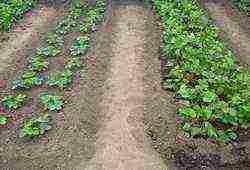
Victoria boarding time
The best time to plant strawberries is spring or autumn. In the spring, plants are planted as early as possible - immediately after warm weather sets in and the threat of recurrent frosts disappears. In the fall, Victoria should be planted from the second half of August to September 15, and then in the next planting season they will delight with the first berry.
Seedlings with a closed root system, purchased in cassettes or containers, can be planted as early as mid-July. The main thing is to choose a cloudy day for planting and moisten the soil well. Seedlings planted in summer will have time to take root well before winter and will give a full harvest next spring.
Some gardeners grow planting material with their own hands, although this is a long and laborious process. After all, it will take at least three years to get a full-fledged independent plant.Therefore, experts advise buying seedlings from well-known nurseries, and preferably in cassettes or containers. This is the safest and fastest way to grow crops.
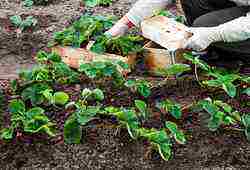
Site selection
The site designated for Victoria should be sunny and level, with a slight southwest slope. It is not worth choosing steep slopes for planting this culture, from which the wind blows off snow in winter, and spring waters carry away part of the fertile layer. Lowlands and depressions, where melt water lasts for a long time, are unsuitable for cultivating strawberries.
The soil on the site should contain a lot of organic matter. Light loams, black earth, or gray forest soil are best suited for growing this berry outdoors. Groundwater should be located at least 1 m to the surface of the earth.
Victoria grows well after herbs, cereals, onions, garlic, petunias, marigolds. You should not plant the berries in the beds where tomatoes, eggplants, and cucumbers previously grew. After 3-4 years, the plants are transferred to a new location.
Spring planting
For the spring planting of Victoria, the soil must be prepared in advance, even before the beginning of winter. The site must be carefully dug up, weeds must be removed and the following fertilizers must be applied for each square meter of area:
Seedlings for planting in the spring must be selected strong and healthy. Before planting in the ground, it should be hardened for several days by placing in a cool place.
Between the plants located in the same row, leave 25-30 cm. To ensure ease of maintenance, the beds are separated by aisles of 40-50 cm wide.
Before planting, the roots of the plant are cut to 10 cm and holes are dug to such a depth that the root system fits vertically. When planting a Victoria, special attention should be paid to the location of the neck of the bush.
The neck of the bush should be flush with the soil surface. With a high planting, the roots can dry out, and with a very strong deepening, the plant can rot.
The planted plant is abundantly watered and covered with a special material to protect it from frost or sunburn.
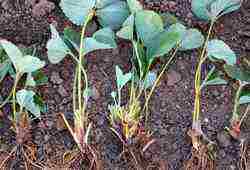
Planting in autumn
Autumn planting of strawberry seedlings is considered optimal, since a full harvest can be harvested from young bushes in the spring of next year. Plants planted in early spring will also start bearing fruit next season, but will have to be cared for all summer.
Before the autumn planting, the site should be processed and prepared in early spring, adding the necessary fertilizers. If every piece of land is valuable in the garden, these beds can be temporarily occupied with onions, garlic or celery, that is, early ripening vegetables.
Before planting seedlings in open ground, the roots should be treated with a preparation against the fungus (fungicide) and young plants should be kept in a cool place for several days.
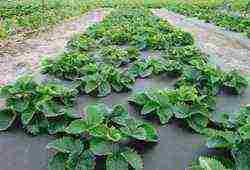
Growing Victoria
In the first year after planting Victoria in the ground, do not strive to get a large harvest. On the contrary, in order for the plant to strengthen and grow the root system, it is necessary to remove the antennae and flowers that appear.
Caring for adult plants involves a number of activities.
- Processing of a plot with strawberries. In early spring, as soon as the growing season begins, it is necessary to collect old mulching material from the beds and between rows, remove dry and damaged leaves, and loosen the soil between the plants.
- Watering. Large juicy fruits cannot be obtained without proper, balanced watering. There should be enough moisture for the normal growth of the plant, and at the same time, strong waterlogging of the soil can provoke rotting of the root system. Victoria is watered once every 10 days at the rate of 10-12 liters per 1 sq. m starting from mid-April. In summer, with the onset of heat, the frequency of watering can be increased up to 4 times a week. In autumn, in August and September, the number of waterings is reduced to 2 times a week. It is better to carry out watering work in the morning, trying not to get water on the leaves and flower stalks.During flowering, drip irrigation is used.
- Loosening. After the next watering, the soil around the plants and between the rows must be carefully loosened, trying not to damage the adventitious roots that lie at the surface of the earth. This is necessary in order to make the soil breathable and facilitate the flow of oxygen into the root system.
- Weeding. Planting maintenance involves regularly removing weeds from the beds and aisles. Weed grass not only depletes the soil, taking away most of the moisture and nutrients, but is also a breeding ground for pathogenic bacteria and a refuge for pests. To stop the appearance of weeds, you can cover the planting area with mulching material: sawdust, wood chips, dry needles - or cover it with agrofibre.
These are the main activities that every gardener who grows Victoria in open areas should regularly carry out.
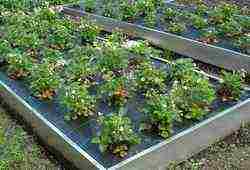
Leaving during flowering
The appearance of the first peduncles falls in mid-May. It is during this period that the future harvest is laid, the quality and quantity of which depends on the correct care. To feed the plant during this period, potash fertilizers, humus and ash are introduced into the soil. You can increase the number of inflorescences using a boric acid solution prepared at the rate of 1 tsp. on a bucket of water, which is sprayed with green bushes.
It is especially important to weed and loosen the area, preventing the appearance and growth of weeds. To get a large berry, you need to use a pruner to remove all excess antennae and leaves that absorb moisture and nutrients from the soil.
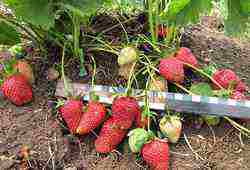
Fertilizing Victoria
Caring for Victoria cannot be imagined without feeding this plant. Fertilizers should be applied at least three times per season.
- In early spring, after processing the area allotted for the berry, nitroammophoska is introduced into the soil. Nitrogen, phosphorus and potassium, which are part of this fertilizer, are the most essential substances for plant development.
- During budding, potassium is added to the soil, a large amount of which is contained in ash, chicken manure infusion, and potassium nitrate. After picking the berries, the plants are fed again with nitroammophos, dissolving 2 tbsp. l. in 10 liters of water.
- And the last time Victoria is fed with urea in August. This contributes to the formation of new flower buds and more abundant fruiting in the next year. The solution is prepared at the rate of 30 g of urea per 10 liters of water.
On sale there is a complex fertilizer developed specifically for strawberries and increasing yields by 30%.
Growing Victoria is an incredibly rewarding and interesting activity, although it requires certain skills and knowledge. After studying the advice of experts and providing proper care for the plants, it will not be difficult to get a decent harvest of this delicious berry.
> and will be published shortly.
Attention! Copying of site materials is possible only with the permission of the administration and with an active link to the source.
The information is provided for informational purposes only. Self-medication can lead to undesirable consequences!
At the first sign of illness, see your doctor.
Read also
Victoria - a delicious victory with little secrets
Greetings, dear readers!
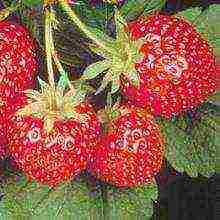 One of the first varieties of well-known garden strawberries is the Victoria berry. Victoria fruits have an extraordinary aroma; they look beautiful and appetizing on a platter. Victoria is a berry that has many valuable properties and contains nutrients. It contains vitamin C. The name Victoria is very suitable for this berry. To feel Victoria - victory - you need to see a well-groomed garden of beautiful berries. And for this you need to properly care for the plant.
One of the first varieties of well-known garden strawberries is the Victoria berry. Victoria fruits have an extraordinary aroma; they look beautiful and appetizing on a platter. Victoria is a berry that has many valuable properties and contains nutrients. It contains vitamin C. The name Victoria is very suitable for this berry. To feel Victoria - victory - you need to see a well-groomed garden of beautiful berries. And for this you need to properly care for the plant.
Let's talk about how to grow victoria in the garden area.
Victoria breeds with a mustache. They usually appear by mid-summer. For further cultivation of the plant, use the rosettes located next to the mother bush.Mustache from biennial plants works best. You need to plant a rosette with four leaves on the ridge, separating it from the common plant.
Victoria bushes are planted in spring or autumn. But at the same time, the site for planting is prepared in advance. For spring planting, the beds are prepared in the fall, and for the fall - in June, not forgetting to fertilize the soil. It is advisable to plant Victoria on level ground with a slope towards the west. In winter, snow should accumulate on the site, so that the Victoria bushes do not die. In this regard, the garden bed must be positioned so that it is not strongly blown by the wind.
In order to plant the bushes, it is necessary to make holes in the prepared bed in which the mustache dug out together with the lump of soil are placed. This should be done immediately, without leaving the outlet for the next days.
Berry - Victoria is susceptible to infection with gray rot, in order to prevent this disease, the soil on the ridge is mulched with wood shavings or straws, 10 cm thick. At the same time, the leaves of the plant are not covered. When the crop is harvested, the ground around the berry bushes must be loosened. When the roots are exposed, the berry is huddled, regular weeding of Victoria is the key to getting a good harvest.
Before flowering, in order to prevent gray rot disease, it is necessary to spray with an iodine solution.
Special requirements apply to the watering of the bushes. Moderate watering of the plant will allow you to save a large amount of vitamin products. Without additional moisture, Victoria will grow if you cover it with snow in winter, carry out high-quality weeding, and do timely and regular loosening of the soil.
For today it's all about how to grow victoria Location on.
Don't miss out on the chance to eat some victoria berries. Its taste is canceled, and the benefits are immeasurable. When consumed, you must carefully rinse the fruit under running water. You can use garden strawberries for fasting days due to their low calorie content. Drinking a decoction of berries and leaves will help you lose those extra pounds.
See you, dear friends!
